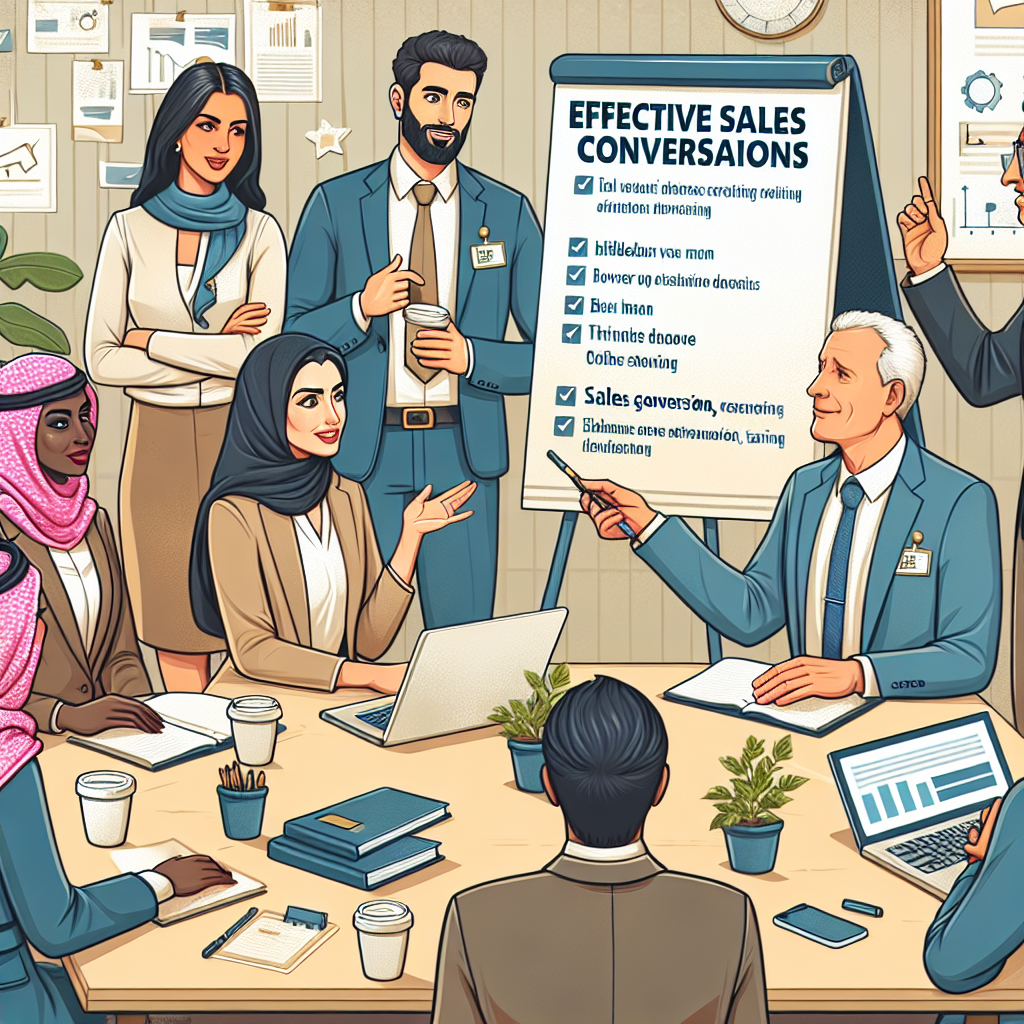Understanding Your Product Inside Out
Knowledge is Power
When it comes to effective sales conversations, the first step is truly understanding your product. I can’t stress enough how important it is for your team to know the ins and outs. A good grasp of product features, benefits, and limitations builds a solid foundation. Your team won’t just sell; they’ll confidently discuss how your product solves a problem.
Start with training sessions that dive deep into the product. Encourage your team to ask questions until they feel comfortable. I’ve always found that a little creativity goes a long way—role-playing scenarios can really help solidify this knowledge. It’s like they’re living through the sales experience before they even hit the floor!
Additionally, updating your team regularly about any changes or new features is crucial. The sales landscape can change quickly, so keeping your communication channels open ensures everyone is on the same page.
Know Your Unique Selling Proposition
Part of understanding your product is recognizing what sets it apart in the marketplace. I love to phrase this as “finding your differentiators.” Why should someone pick your product over a similar one? Your team needs to speak to these unique features in every conversation.
Hosting brainstorming sessions can be beneficial here. This is a chance for your team to collaborate and come up with ways to present those USPs effectively to potential customers. Often, I find that team members have unique perspectives based on their experiences that can uncover new angles to approach customers.
Make sure this understanding is practiced regularly. I always encourage adopting a culture of continuous learning. As new sales techniques or methods come into play, keeping the USP sharp and relevant will ensure your team isn’t caught off guard.
Practice, Practice, Practice
After the initial training on product knowledge, practice becomes the vital next step. Encourage the team to role-play various sales scenarios. It’s one thing to know your stuff, but it’s another thing entirely to be able to communicate that passion and knowledge effectively to clients.
In my experience, even veteran team members benefit from revisiting the basics and engaging in practice sessions. I’ve noticed that the dynamics of role play help in overcoming anxiety. Plus, it allows the team to receive immediate feedback, refining their techniques all in real-time.
Lastly, don’t shy away from inviting feedback on their delivery and body language during these practice sessions. Sometimes the smallest adjustments can lead to a significant improvement in engagement with customers.
Building Rapport with Customers
The Art of Listening
Rapport-building begins with listening. It’s amazing how much you can learn when you genuinely pay attention to what a customer is saying. I find that many salespeople are so eager to pitch that they overlook the potential in listening carefully first.
Encourage your team to practice active listening techniques. An easy way to do this is by summarizing what the customer has said during the conversation. This shows the customer that they’re being heard and understood, which goes a long way in building trust.
Creating a comfortable atmosphere for the customer ensures they feel valued. It’s about making the conversation feel like a collaboration rather than a transaction. When your team embraces this mindset, the sales journey transforms into a more enjoyable experience for both parties.
Establishing Mutual Trust
Trust is critical in any sales conversation. I’ve seen firsthand how a lack of trust can hinder sales progress. Your team should be transparent with customers, providing honest information about what your product can and cannot do. No one likes feeling sold to, but everyone enjoys feeling informed.
Encourage your team members to share personal stories where appropriate. I’m a firm believer that showing authenticity can resonate deeply with customers. If they can relate to you on a personal level, they’ll be more open to trusting your guidance on the product.
Creating detailed customer personas can also support this trust-building effort. When your team understands who they are talking to—what their needs and pain points are—they can tailor their approach to show how your product genuinely meets those needs.
Follow-Up After the Initial Conversation
One of the best ways to solidify rapport is through timely follow-up communication. Often, a well-crafted follow-up message can leave a lasting impression. I always advise my team to make it a point to reach out after a conversation, whether it’s to answer lingering questions or simply to check in.
Utilizing automated systems for follow-ups can be helpful, but make sure they feel personalized. A customer should feel like they’re receiving more than just a generic email. A friendly reminder or a thank-you note goes a long way in keeping the conversation alive and indicating you value the customer.
Moreover, following up is an excellent opportunity to nurture that relationship over time. It can lead to up-sells or referrals down the road, so I always advocate making the most of that touchpoint to further emphasize the relationship over the sale.
Effective Questioning Techniques
Open-Ended Questions
Using open-ended questions is essential in any sales conversation. These questions encourage customers to express themselves fully rather than just offering one-word answers. I tell my team that the right questions can open up a whole new discussion that you may not have anticipated!
When crafting these questions, I recommend they start with “what,” “how,” or “why.” For example, asking “What challenges are you currently facing?” invites more insightful responses compared to something limiting like “Are you facing challenges?”
This approach allows the customers to feel comfortable sharing their thoughts, leading to a more meaningful conversation. Plus, with the right questions, your team can tailor their pitch to the specific needs of the customer. It’s a win-win!
Probing Questions
After collecting initial information, your team should be equipped to ask probing questions. These help dig deeper into the customer’s needs and desires. I often emphasize the importance of asking clarifying questions to ensure they fully understand the customer’s position.
Start with phrases like, “Can you elaborate on that?” or “Could you tell me more about your experience?” This not only shows genuine interest but also helps the salesperson gather the right information to present your product effectively.
Remember, the goal here is not to interrogate but to create a comfortable space for conversation. The more your team practices this, the easier it becomes, and the more organic the flow of conversation will feel.
Closing Questions
As the conversation edges towards the end, closing questions become crucial. These help gauge the customer’s interest and readiness to proceed. I always encourage my team to ask outright questions that invite a response—questions such as “How do you feel about moving forward?” can be very effective.
Don’t shy away from asking for feedback on their previous experiences, too. Questions like “What have you liked most about our discussion so far?” can reveal key insights. This not only serves as market research but can help reinforce the value of your product in their mind.
Ultimately, closing questions should feel natural and not pressure-driven. They’re about facilitating a discussion on next steps, not pushing for an immediate sale. Keeping things friendly and open-ended ensures the customer does not feel cornered.
Handling Objections Gracefully
Normalize Objections
Handling objections is a normal part of sales, and instead of seeing them as roadblocks, I encourage my team to view them as opportunities. Every objection is a chance for further understanding and conversation, and this mindset can change how your team approaches these moments.
I remind my team that objections often mean the customer is considering the offer seriously. Instead of getting defensive, they should embrace it. Assessing objections through curiosity rather than hostility builds rapport and allows for a more productive outcome.
Practice makes perfect! Role-playing common objections and developing agile responses can empower your team to feel prepared when they face these situations in real conversations.
Empathy and Understanding
One key aspect in overcoming objections is displaying empathy. Customers want to feel heard, and when they express concerns, it’s crucial for your team to acknowledge them sincerely. A simple “I understand why you feel that way” can resonate deeply.
This goes hand-in-hand with validating their feelings. When your team shows they understand the customer’s concerns, it builds credibility and trust. A person is less likely to feel dismissed and more likely to open up a dialogue.
Empathy can also enable your team to tailor a solution that addresses those objections head-on. The goal is not just to overcome the objection but to strengthen the connection and further showcase how your product fits their needs.
Offering Solutions
After addressing objections appropriately, your team should be ready to offer tailored solutions. This is where all that practice with open-ended questions pays off. For instance, if a customer expresses a concern over price, your team can pivot the conversation to the value they’re getting.
Encouraging your team to think on their feet will enhance their responsiveness to objections. This is where their product knowledge and rapport-building skills really come into play as they craft solutions that cater to the customer’s unique situation.
Finally, when posing solutions, always encourage a check-back tactic. For example, “Would this solution alleviate your concern?” This keeps the conversation alive and demonstrates commitment to finding the right fit for the customer.
Continuous Learning and Improvement
Regular Feedback Sessions
To keep things fresh and to ensure constant growth, establishing regular feedback sessions is essential. I’d often sit down with my team to review conversations, highlight what went well, and address areas for improvement. It’s about creating an open line of communication where everyone feels comfortable sharing their thoughts.
Using call recordings or simulations can be an excellent resource here. Analyzing actual conversations helps your team identify patterns—what’s resonating with customers and what isn’t. Getting feedback on these is a cinch, and it allows for actionable insights to be extracted.
Encouraging a culture of growth through constructive criticism, rather than punitive measures, fosters a healthier team dynamic and encourages everyone to give their best in every sale.
Investing in Professional Development
Investing in professional development is crucial for a thriving sales team. Offering workshops, attending seminars, or even inviting guest speakers can bring fresh perspectives that enrich your team’s skill set. I always believe that continuous education keeps your team adaptive and well-equipped to tackle new challenges.
Training doesn’t just have to be focused on hard skills—soft skills like emotional intelligence, negotiation, and relationship-building are equally important. Emphasizing this balance in training can lead to holistic growth for each team member, ultimately benefiting your sales conversations.
Moreover, mentoring programs can foster deeper relationships and allow for knowledge sharing across different levels in your team, which is invaluable. Pairing experienced members with newer ones can create growth opportunities that benefit the entire team.
Adapting to Industry Changes
Lastly, your training should always consider the ever-evolving sales landscape. Regularly updating your team on industry shifts, competitor offers, and emerging trends will keep them on their toes. This adaptability is fundamental in a world where consumer behaviors and preferences can change overnight.
I use resources like market research reports, customer feedback surveys, and competitor analysis to stay ahead of the curve. Sharing these insights with your team fosters a mindset geared toward innovation and forward-thinking.
Encouraging flexibility in strategies, along with the people skills needed for success, can set your team apart from the rest. They’re better equipped to anticipate challenges rather than react to them as they arise.
Frequently Asked Questions (FAQ)
What are the key areas to focus on for training my sales team?
The core areas include understanding the product thoroughly, building rapport with customers, effective questioning techniques, handling objections, and ensuring continuous learning.
How can my team better build rapport with customers?
Emphasize the importance of listening actively, establishing mutual trust through honesty, and following up after initial conversations. Each of these components helps foster a friendly connection.
What types of questions should my team be asking during sales conversations?
Your team should utilize open-ended questions to gather insights, probing questions to dive deeper into customer needs, and closing questions to gauge readiness to move forward.
How can we effectively handle customer objections?
Normalize objections as part of the sales process, approach them with empathy, and offer tailored solutions that address the customer’s concerns directly.
What can we do to ensure continuous improvement in sales techniques?
Regular feedback sessions, investing in professional development, and adapting to industry changes will create a culture of growth and adaptability within your sales team.



